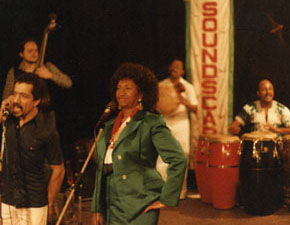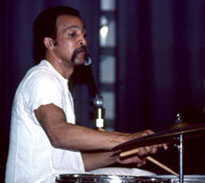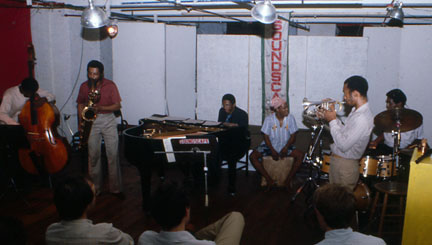SOUNDSCAPE

Celia Cruz - to her left is Milton Cardona - in the back are Any Gonzalez, Orlando "Puntilla" Rios and Daniel Ponce on congas
500 West 52nd Street (southwest corner of Tenth Avenue)
by Andy Schwartz
(February 2009)
A sparsely appointed West Side loft dedicated to the presentation of improvisational and global music, Soundscape was the spiritual predecessor to such contemporary NYC venues as the Knitting Factory and The Stone. Soundscape was founded by Verna Gillis, a City College graduate who earned her PH.D in ethnomusicology from Union Graduate School in 1975. Verna did extensive field recording in Haiti, the Dominican Republic, Surinam, Peru, and Ghana; 25 albums of her material were released on the Lyrichord and Smithsonian Folkways labels. After producing the documentary film Rara: Carnival Week in Haiti and a series of concerts on behalf of New York radio station WBAI, Verna Gillis opened Soundscape in 1979.I started doing live radio on WBAI around 1974 with a program called "Soundscape: Music from Everywhere." The word "soundscape" came from a book called The Tuning of the World by R. Murray Schafer. It just takes it all in.
I had the great fortune to be married to [sculptor and alto saxophonist] Bradford Graves, who knew everything about music. Brad kept me eternally hip— he knew everything that was going on. He was the one who'd told me about rara and accompanied me on the trip to Haiti and encouraged me to go for my Ph.D.
Brad found the space that became Soundscape. He had a studio at 549 West 52nd Street, and in 1978 he told me "you know, there's an empty space on the corner— I see signs for it."
It was a funky New York City HPD [Department of Housing Preservation & Development] building, probably built around 1900. HPD itself occupied the third floor, and there was a garbage hauling business on the first and second floors. This area of the West Side was very desolate in those days. You know the phrase "location, location, location"? Well, Tenth Avenue and 52nd Street was like the other side of the moon. Today, it's a neighborhood. It was not a neighborhood in 1979.
To help Graves obtain grants for public art works, Gillis had created a 501C non-profit corporation, American International Sculptor Symposiums, which name was changed to Soundscape. In March 1979, she took possession of the fifth floor of 500 West 52nd Street, nearly 6,000 square-foot space divided into two rooms. The initial monthly rent was $225, on a month-to-month lease.
It was a primitive space but a great space, and it turned out that the larger of the two rooms had great acoustics. Brad built a plywood platform, which he painted black. I bought a hundred folding chairs on Canal Street, and a hundred pieces of foam for people to sit on. We strung clip-on lights from the existing pipes... I was teaching at Brooklyn College and Brad was teaching at Fairleigh Dickinson, so we had some money for these things.
Don Cherry wanted to name it "Bird's Nest." Ornette [Coleman] came in and told me "you have to videotape everything." Actually, Ornette and Cecil Taylor worked together at Soundscape before we opened. Ornette had a Bosendorfer piano delivered to the space for Cecil—technicians came every morning to tune it. Ornette still has the [unreleased] tapes of their sessions.
Kunle Mwanga managed Ed Blackwell, and he inaugurated Soundscape by producing the first festival with people like Blackwell, Oliver Lake, David Murray…It was really more about breaking in the space. It took me a year just to order toilet paper in bulk!
September '79 was like the official opening. Brad suggested a European-American festival, and we booked Derek Bailey, Steve Lacy, John Tchcai, James Blood Ulmer, Hans Reichel... It was great.
A typical Soundscape evening presented one artist performing two sets, "theoretically starting at 8:00 p.m." For the first year, admission was $5.00 with a dollar off for students. Soundscape never had a liquor license, but beer and wine were sold illicitly. Nineteen-eighty proved to be a pivotal in the venue's history.
Eddie Figueroa ran the New Rican Village [at 101 Avenue A, later the Pyramid Club]. In the spring of 1980, they'd gotten evicted and needed a home. So Eddie brought that incredible scene to Soundscape. The best Latin jazz scene in New York, every Tuesday night: Jerry and Andy Gonzalez, Hilton Ruiz, Jorge Dalto— the best!
I had gone to Cuba in December 1978 and when I opened Soundscape, it was as though I were preparing for the Mariel boatlift [in September 1980]. Soundscape became the home for all those Cuban musicians in New York. For example, it was the first place that Paquito d'Rivera played in New York and the place where he met the members of his first quartet.

Paquito d'Rivera on sax and Daniel Ponce on congas
Live at Soundscape – October 1980 [highlights](10) Phil Niblock
Born in rural Indiana in 1933, Niblock is an experimental composer, instrumentalist, and video/filmmaker active in New York since the mid-Sixties. "This is music which (Niblock always recommends high volume) has an incredible sense of presence. As with his films, change is very gradual, and the music becomes more of an environment than what music generally is, a narrative. Like other minimalist music, listening to Niblock's compositions requires a definite change in perceptual approach; you need to immerse yourself in it, experience it at a direct intuitive level, allow your attention to drift and follow subtle patterns in the overall density." [Brian Duguid, 1996](11) Wayne Horvitz
Now residing in Seattle, keyboardist and composer Horvitz has led or co-led the creative fusion groups Pigpen, The President, and Zony Mash. He has worked extensively with John Zorn, Bill Frisell, and his wife, the singer/songwriter Robin Holcomb.(25) Derek Bailey & Evan Parker
Guitarist Derek Bailey and saxophonist Evan Parker are leading figures in the history of European improvisational music. "One of the few players not only willing but anxious to demonstrate his affinity for late-period John Coltrane" (AllMusic.com), Parker met Bailey circa 1968. Together they formed the Music Improvisation Company and later co-founded Incus Records with drummer Tony Oxley. The partners fell out a few years later, and Parker and Bailey never played or even spoke with each other again. The guitarist continued to perform and to run Incus with his wife, Karen Brookman; in 1980, he published a book, Improvisation. At the time of his death at age 75 on Christmas Day 2005, Bailey was scheduled to perform and curate shows at The Stone (on Avenue C in Manhattan) during the month of May 2006. Evan Parker has appeared on an estimated 250 albums including Eleventh Hour (ECM, 2005), credited to the Evan Parker Electro-Acoustic Ensemble.(31) Steve Lacy Quintet
Lacy (born 1934 in New York) was one of the greatest soprano saxophonists of all time and a leading interpreter of the music of Thelonious Monk. He moved to Paris in 1970 and lived there until a few years before his death in 2004.


Milford Graves playing solo & Hamiet Bluett's Ensemble at the Performance Space
I will tell you: I was a crazy person during the Soundscape years. It was a perfect example of what they call "self-will run riot." I definitely got a lot done but also at great personal expense.
I never felt that we were competing with the downtown jazz clubs. For one thing, with the exception of someone like Steve Lacy, most of the artists that performed at Soundscape would not have been booked at the [Village] Vanguard or Sweet Basil.
And I did different things with them. Archie Shepp gave a poetry reading. Sun Ra played solo piano. He also came in once to give a lecture and as soon as it started, all the lights went out!
There were a lot of solo performances and lots of duos. Sirone did some incredible solo shows. Jimmy Lyons. Arthur Rhames. For a while, I did a Wednesday residency every week with Sonny Sharrock and his band. John Zorn and Daniel Ponce both played Soundscape many times. We had an East-West German Festival, and photography exhibits by Val Wilmer and Spencer Richards.
One time, I booked Zorn for a show. They played, then there was the break, and after a while I went up to him and said, "Isn't it time you started again?" And John replied, "We have started again."
There were some nights when there were so few people [in attendance] that it was almost excruciatingly painful for me. So for about a year, to make ends meet, I illegally rented Soundscape on the weekends to some promoters who came in and did an after-hours thing [from 2:00-8:00 a.m.].
I produced King Sunny Ade's first concerts in this country, in 1983, at the Savoy [at 141 West 44th Street] and then at Roseland. I did Youssou N'dour at The Ritz [now Webster Hall], then Youssou and Salif Keita at the Beacon Theater. Like Daniel Ponce, these were musicians who were deeply rooted in a traditional culture but expressing it in a pop idiom.
In that summer of '83, I did the first real hip-hop concert at the [Hudson River] pier on the West Side, with Afrika Bambaataa, New Edition, and Kurtis Blow. I did a "Reunion on the Pier" with Hector Lavoe, Yomo Toro, and Willie Colon. I was starting to step out and Soundscape was too small for what my interests were becoming. I also started managing Youssou N'dour, which I did for twelve years. That was a total shift and a good thing for me—I'd never really built an organization.
Verna Gillis' final months with Soundscape were "wrought with anxiety." Bradford Graves suffered his first heart attack in 1984, and she closed Soundscape later that year. Graves died April 16, 1998 at age 59.
I kept the [Soundscape] space and illegally sublet it to different tenants: a sound company, a sculptor, a painter. It was the first time I made any real money from it! Finally, one of these subtenants turned me in to the City, got the space put in their name, and had me evicted. This was in, I think, 1991. I was pissed when it happened, of course, but I'd been subletting illegally and it was good to be rid of it. The building is still standing.
Click here to see a full-sized B&W ad poster from 1993, showing then-upcoming concerts at Soundscape, including Youssou N'Dour (783 KB, JPG file)

Ola Daru (on trumpet) and band